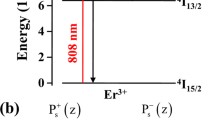Abstract
We present a cascaded system designed with Er3+-doped, Tm3+-doped and Nd3+-doped fibers to realize amplified spontaneous emission (ASE) spectra covering 0.4–2.0 µm. The system is excited with a pump laser emitting 808 nm photons with 500 mW pump power. The emission spectra of the cascaded system covering 0.4–2.0 µm are realized with the Er3+, Tm3+ and Nd3+ ion doping densities optimized to 8 × 1019, 2 × 1020 and 8 × 1020 ion/m3, respectively, and the fiber length optimized to 1m. Numerical methods reveal that the peak ASE power for the cascaded system can reach 20.9 mW. A minimum ASE power of 4.39 mW is attainable. Using numerical calculations and analytical techniques, we provide a detailed insight into optimized Er3+-doped, Tm3+-doped and Nd3+-doped fiber lengths and their doping concentrations for ASE power spectra covering 0.4–2.0 µm. We believe that the cascaded system can potentially provide significant applications in various optical fields which include but not limited to wavelength-division multiplexing, various optical communications and other salient medical imaging processes.
Similar content being viewed by others
References
MEARS R J, REEKIE L, JAUNCEY I M, et al. Low-noise erbium-doped fiber amplifier operating at 1.54 µm[J]. Electronics Letters, 1987, 23(19): 1026–1028.
DESURVIRE E, SIMPSON J R, BECKER P C. High-gain erbium-doped travelling-wave fiber amplifier [J]. Optics Letters, 1987, 12(11): 888–890.
AGRAWAL G P. Fiber-optic communication systems [M]. 4th ed. New York, USA: Wiley, 2010.
DIGONNET M J F. Rare-earth-doped fiber lasers and amplifiers [M]. 2nd ed. New York, USA: Marcel Dekker, Inc., 2001.
FLORIDIA C, CARVALHO M T, LÜTHI S R, et al. Modeling the distribution gain of single- (1050 nm or 1410 nm) and dual-wavelength (800 nm+1050 nm or 800 nm+1410 nm) pumped thulium-doped fiber amplifiers [J]. Optics Letters, 2004, 29(17): 1983–1985.
ZHU B, NELSON L E, STULZ S, et al. 6.4-Tb/s (160 × 42.7 Gb/s) transmission with 0.8 bit/s/Hz spectral efficiency over 32 × 100 km of fiber using CSRZ-DPSK format [C]// Optical Fiber Communication Conference. Atlanta, Georgia, USA: Optical Society of America, 2003: PD19.
KEISER G. Optical fiber communications [M]. 2nd ed. Singapore: McGraw Hill Companies Inc, 1991.
ROY F, BANIEL P, FAGES C, et al. Optimal pumping schemes for gain-band management for thulium-doped fiber amplifiers [C]// Optical Fiber Communication Conference. Anaheim, California, USA: Optical Society of America, 2001: TuQ7.
HOSSAIN N, NAJI A W, MISHRA V, et al. Numerical analysis and optimization of remotely pumped double pass erbium doped fiber amplifier [J]. IEICE Electronics Express, 2007, 4(5): 172–178.
MINISCALCO W J. Rare earth doped fiber lasers and amplifiers: Optical and electronic properties of rare earth ions in glasses [M]. New York, USA: Marcel Dekker, 1993.
YAM S S H, KIM J. Ground state absorption in thulium-doped fiber amplifier: Experiment and modeling [J]. IEEE Journal of Selected Topics in Quantum Electronics, 2006, 12(4): 797–803.
ALLEN R, ESTEROWITZ L, AGGARWAL I. An efficient 1.46 µm thulium fiber laser via a cascade process [J]. IEEE Journal of Quantum Electronics, 1993, 29(2): 303–306.
EICHHORN M. Numerical modeling of Tm-doped double-clad fluoride fiber amplifiers [J]. IEEE Journal of Quantum Electronics, 2005, 41(12): 1574–1581.
BASTOS-FILHO C J A, MARTINS-FILHO J F, GOMES A S L. 38 dB gain from double-pass singlepump thulium doped fiber amplifier [C]//IEEE Microwave and Optoelectronics Conference. Foz do Iguacu, Brazil: IEEE, 2003: 125–128.
PETERKA P, FAURE B, BLANCE W, et al. Theoretical modelling of S-band thulium-doped silica fibre amplifiers [J]. Optical and Quantum Electronics, 2004, 36(1/2/3): 201–212.
KASAMATSU T, YANO Y, ONO T. 1.49-µm-band gain-shifted thulium-doped fiber amplifier for WDM transmission systems [J]. Journal of Lightwave Technology, 2002, 20(10): 1826–1838.
SAKAMOTO T. S-band fiber optical amplifiers [C]//Optical Fiber Communication Conference. Anaheim, California, USA: Optical Society of America, 2001: TuQ1.
CARTER J N, SMART R G, TROPPER A C, et al. Thulium-doped fluorozirconate fiber lasers [J]. Journal of Non-Crystalline Solid, 1992, 140: 10–15.
JACKSON S D, KING T A. Theoretical modeling of Tm-doped silica fiber lasers [J]. Journal of Lightweight Technology, 1999, 17(5): 948–956.
ZEMON S, PEDERSON G, LAMBERT G, et al. Excited state absorption cross section and amplifier modelling in the 1300nm region of Nd-doped glasses [J]. IEEE Photonics Technology Letters, 1992, 4(3): 244–247.
ZEMON S, PEDERSEN G, LAMBERT G, et al. Excited-state-absorption cross sections and amplifier modeling in the 1 300-nm region for Nd-doped glasses [J]. IEEE Photonics Technology Letters, 1992, 4(3): 244–247.
MINISCALCO W J. Rare-earth-doped fiber lasers and amplifiers: Optical and electronic properties of rare earth ions in glasses [M]. 2nd ed. New York, USA: Marcel Dekker, Inc., 2001.
MCCUMBER D E. Einstein relations connecting broadband emission and absorption spectra [J]. Physical Revision A, 1964, 136(4): 954–957.
GILES C R, DESURVIRE E. Propagation of signal and noise in concatenated erbium-doped fiber optical amplifiers [J]. Journal of Lightwave Technology, 1991, 9(2): 147–154.
OLSHANSKY R. Noise figure for erbium-doped optical fiber amplifiers [J]. Electronics Letters, 1988, 24(22): 1363–1364.
MACLOED H A. Thin-film optical filters [M]. 4th ed. Boca Raton, FL, USA: Taylor and Francis Group, 2010.
KNITTL Z, Optics of thin films [M]. London, UK: Wiley, 1976.
Author information
Authors and Affiliations
Corresponding author
Additional information
Foundation item: the National Natural Science Foundation of China (Nos. 60377023 and 60672017), the Program for New Century Excellent Talents in Universities (NCET), and the Shanghai Optical Science and Technology Project (No. 05DZ22009)
Rights and permissions
About this article
Cite this article
Nkonde, S., Jiang, C. Theoretical Modelling of Cascaded Er3+-Doped, Tm3+-Doped and Nd3+-Doped Fibers for 0.4 to 2.0 µm Emission Spectra. J. Shanghai Jiaotong Univ. (Sci.) 24, 754–762 (2019). https://doi.org/10.1007/s12204-019-2122-2
Received:
Published:
Issue Date:
DOI: https://doi.org/10.1007/s12204-019-2122-2




